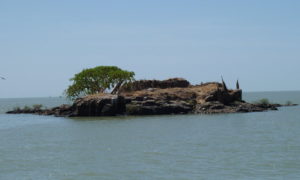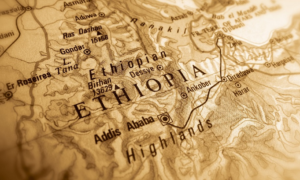Article from The Ethiopian Herald
Little about Bale Mountains National Park Featured
Jun 2015
Nominated in 2009 to the World Heritage Tentative List, Bale Mountains National Park (BMNP) is a national park in Ethiopia with one of the highest incidences of animal endemicity of any terrestrial habitat in the world. The Park encompasses an area of approximately 2,150 km2, and is divided into five distinct and unique habitats: the Northern Grasslands (Gaysay Valley), Northern Woodlands (Park Headquarters), Afro-alpine Meadows (Sanetti Pleateau), Erica Moorlands, and the Harenna Forest. The park is known for being home to the largest populations of both the endemic and endangered Ethiopian wolf (Canis simensis) and mountain Nyala (Tragelaphus buxtoni), as well as the endemic Bale monkey (Chlorocebus djamdjamensis) and giant mole rat (Tachyoryctes macrocephalus). The endangered painted hunting dog (Lycaon pictus) once existed in the park (with relict packs reported in the 1990s), but may now be extirpated due to human population pressures in this region.
The Bale Mountains National Park is located in southeastern Ethiopia, 400 km southeast of Addis Ababa and 150 km east of Shashamene in the Oromia Regional National State. It belongs to the Bale-Arsi massif, which forms the western section of the southeastern highlands. The boundary of the BMNP lies within five woredas: Adaba (west), Dinsho (north), Goba (northeast), Delo-Mena-Angetu and Harena-Buluk (southeast). The park area is encompassed within geographical coordinates of 6º29′ – 7º10’N and 39º28′ – 39º57’E.
The Bale Mountains were formed prior to the formation of the Rift Valley from lava outpourings, which covered all underlying rock formations between 38 and seven million years ago. The rocks of the volcanic outpourings are pre-dominantly trachytes but also include rhyolites, basalts and associated agglomerates, and tuffs. The main Bale highlands consist of a vast lava plateau with at least six volcanic cones, each more than 4,200 meters high, which have been considerably flattened by repeated glaciations.
There have been at least two glacial periods in the history of the mountains and they were glaciated as little as 2,000 years ago. During the last ice age, the Bale Mountains were one of the most extensively glaciated areas in Ethiopia with a total area of ice in Bale of approximately 180 km2. There was a 30km2 ice cap around the peak of Tulu Dimtu (the second highest mountain in Ethiopia) on the Sanetti Plateau and individual glaciers of considerable thickness reached down to 3,200 meters. As a consequence, the landscape as we see it today is the lava outpourings much modified by over 20 million years of erosion by water, wind and ice.
There are certain geological features that remain an enigma to geologists and glaciologists such as the striations that appear on shallow hillsides on the Sanetti Plateau. Boulder grooves (large stone sorted stripes two to four meters wide and eighty meters long), till ridges and numerous glacial valleys, such as the Togona Valley on the northeast facing slopes of the Sanetti Plateau, provide evidence of the ice-age effects on the landscape of BMNP. Until the beginning of deglaciation (13,000 to 14,000 years ago) the snowline was at 3,700 meters and the upper tree limit in the Bale Mountains was well below 3,000 meters. Fluctuations in climate over the last historical period, including the last 3,000 years, have dramatically affected the vegetation and other biodiversity in the highlands.
The Bale Mountains play a vital role in climate control of the region by attracting large amounts of orographic rainfall, which has obvious implications for livestock and agricultural production. Some 600 – 1,000 mm fall annually in the lower altitude areas, while 1,000 – 1,400 mm fall in areas of higher altitude, and over 12 million people from Kenya, Somalia and Ethiopia are dependent on water from the Bale massif.
A total of 40 rivers rise in the BMNP area, contributing to five major rivers: the Web, Wabe Shebele, Welmel, Dumal and Ganale. Additionally, the Bale massif is the source for many springs in the lowlands, which are of paramount importance as they are the only source of water year-round. People living south of the National Park are completely dependent on good management of the water resources from the highland areas. If the flow of these rivers is altered in any way – through deforestation, overgrazing of pastures and/or over abstraction for irrigation (all of which are occurring at present) – a highland/lowland imbalance results with loss of perennial water in the lowlands. If such a situation arises, the dry season range of the people and their livestock reduces dramatically and they concentrate about whatever water source remains. It is widely recognized that such uneven distribution of people and livestock leads to rapid and lasting degradation. The people are, therefore, likely to become increasingly food-aid dependent if the water catchment areas of the Bale Mountains are insufficiently protected. There is already evidence that over abstraction of water in the Bale Mountains is occurring.
Furthermore, two rivers emanating from Bale, the Wabe Shebele and Yadot, (tributary of the Ganale) have hydroelectric schemes. The dam on the Yadot River supplies electricity to Delo-Mena, while the dam on the Wabe Shebele provides electricity to the Bale area.
Lastly, there are numerous natural mineral water springs, locally called horas, which provide an essential source of minerals for livestock. The mineral springs within the park are valued for their high mineral content (sodium, potassium, magnesium, zinc and calcium), and local pastoralists believe that in order to maintain good health and milk production their livestock must be given hora water. They will drive their livestock for up to two days to reach the hora springs. It is increasingly apparent, however, that the hora springs have become an excuse for local people to enter the park to gain access to better grazing areas.
Temperatures vary widely throughout BMNP: on the plateau, daytime temperatures are usually around 10 °C (50 °F) with strong winds; in the Gaysay Valley average daytime temperatures are around 20 °C (68 °F), and the Harenna Forest is around 25 °C (77 °F). However, weather changes frequently and sometimes drastically. In elevations over 3,000 meters, night frosts are common. The rainy season is from May until November.
Habitats of the Bale Mountains National Park range from grassland areas around 3,000 meters above sea level, to the second highest point in Ethiopia: Tulu Dimtu at 4,377 meters above sea level. Surrounded by juniper trees and St. John’s wort, waist-high wildflowers and grasses sprout in the Northern Grasslands and Woodlands. The Erica Moorlands are home to a shrub common throughout the world that grows to staggering proportions in Bale. The Afro-alpine moorlands of the Sanetti Plateau is the largest continuous area of its altitude on the entire continent of Africa. Carpeted in lichen covered rocks and punctuated by giant lobelia (Lobelia rynchopatelum) that stand tall and proud at heights of up to 12 meters, the Plateau is also dotted with alpine lakes and streams, providing important ecosystem services as well as wintering and passage stations for rare and endemic birds. The Harenna Forest makes up about half of the park, a fairytale wood of giant trees draped in moss and lichens that seem to drip off the branches. The area is frequently cloaked in mysterious fogs, and wildlife is elusive.
The Bale Mountains are a land of endemism and a critically important area for a number of threatened Ethiopian endemics. Bale Mountains National Park is home to 20 Ethiopian endemic mammals as well as five mammals that are only found in the Bale Mountains. Mammals of paramount importance in BMNP include the Ethiopian wolf (Canis simensis), mountain Nyala (Tragelaphus buxtoni), big-headed mole-rat and Bale monkey. The Afro-alpine area is home to over half of the global population of Ethiopian wolf, the rarest canid in the world: there are just 400 remaining. The northern juniper-hagenia woodlands harbor the largest population of the endemic and similarly endangered mountain Nyala, estimated to be approximately two-thirds of the global population. Furthermore, the entire population the big-headed molerat and most of the Bale monkey population are contained within the park. There are also 12 Ethiopian endemic amphibians and four Ethiopian endemic reptiles living in BMNP.
The Ethiopian wolf is restricted to just six isolated mountaintop areas of the Ethiopian highlands. With a total world population of approximately 400 individuals, the Ethiopian wolf is the most endangered carnivore in Africa and most endangered canid in the world. As a result it is legally protected in the country from any activities that may threaten its survival. Habitat loss, caused by unsustainable and rapidly expanding cattle and crop farming is the most severe underlying threat, but diseases (rabies and canine distemper) transmitted from domestic dogs are a serious immediate threat and have recently caused population crashes in the Bale Mountains.
Additionally, the park holds 26 per cent of Ethiopia’s endemic species including one primate, one bovid, one hare, eight species of rodent, and the entire global population of the big-headed molerat. There are also several rare and endemic amphibians, and two reptiles found only in Bale.
Almost one third of the 47 mammals that live in BMNP are rodents. The rodent community, particularly of the Afro-alpine plateau are keystone species in the Bale Mountains National Park. They are the main prey for Ethiopian wolf, and natural grazers of the Afro-alpine areas where important cryoturbation processes happen.
Other mammals of BMNP include the endemic Menelik’s bushbuck, Bohor reedbuck, klipspringer, grey duiker, warthog, golden jackal, spotted hyena, serval, colobus monkey, lion, leopard, and African wild dog.






